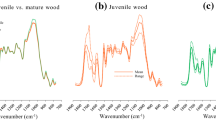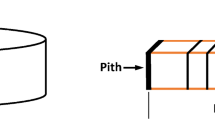Abstract
Near infrared (NIR) spectroscopy calibrations was used to predict radial profiles of cellulose content, wood density, cellulose microfibril angle (MFA) and modulus of elasticity (MOE) in 20-year-old plantation Eucalyptus globulus to identify non-recoverable collapse zones associated with tension wood. Radial (cambium-to-pith) wood cores were extracted at a height of 1.0 m from trees selected to represent a range of silvicultural treatments. NIR spectra were measured at 1 mm intervals along the radial-longitudinal face of each core after drying to 12 % equilibrium moisture content (EMC) at 40 °C. Tangential shrinkage was measured at eight points along each core, following steam reconditioning and re-drying to 12 % EMC. Additional cores from 20 of the sample trees were collected. Radial profiles of density, MFA and MOE were obtained for wood strips prepared from these cores, using the SilviScan 3 wood assessment system. Trait profiles were matched to radial NIR scans of these cores, enabling the development of NIR calibrations using partial least squares (PLS) regression. These, and an existing NIR calibration for cellulose content, were used to predict the radial profiles of the four wood properties for the first set of cores. Predicted wood properties were then related to actual tangential shrinkage measurements and the occurrence of visible bands of non-recoverable collapse. A regression model was developed to reliably predict regions of non-recoverable collapse from NIR-predicted cellulose content and MOE. Micrography of stained wood sections indicated that the collapse was caused by the presence of tension wood.
Zusammenfassung
Mittels NIR-Spektroskopie wurden radiale Profile des Zellulosegehalts, der Holzdichte, des Cellulose-Mikrofibrillenwinkels (MFA) und des Elastizitätsmoduls (MOE) von 20 Jahre alten Plantagen-Eucalyptus globulus erstellt, um nicht rückverformbare Kollapsbereiche in Verbindung mit Zugholz zu erkennen. Radiale Bohrkerne (vom Kambium zur Markröhre) wurden aus Bäumen, die verschiedene waldbauliche Behandlungsverfahren repräsentieren, in 1,0 m Höhe entnommen. Nah-Infrarot (NIR)-Spektren wurden entlang der radialen/longitudinalen Fläche eines jeden Kerns in 1 mm Abständen gemessen, nachdem diese bei 40 °C auf eine Gleichgewichtsfeuchte (ECM) von 12 % getrocknet worden waren. Nach Dampfkonditionierung und erneuter Trocknung auf 12 % EMC wurde das tangentiale Schwindmaß an acht Stellen entlang eines jeden Kerns gemessen. Aus 20 der untersuchten Bäume wurden zusätzliche Kerne entnommen. Radiale Dichte-, MFA- und MOE-Profile wurden an Holzstreifen aus diesen Kernen mittels des Holzanalysegeräts SilviScan 3 erstellt. Aus den Eigenschaftsprofilen und den radialen NIR-Scans dieser Kerne wurden mittels partieller Regression NIR-Kalibrierungen entwickelt. Diese sowie eine bestehende NIR-Kalibrierung des Zellulosegehalts wurden zur Bestimmung der radialen Profile der vier Holzeigenschaften des ersten Kernkollektivs verwendet. Die so bestimmten Holzeigenschaften wurden dann mit den aktuell gemessenen tangentialen Schwindmaßen und dem Auftreten sichtbarer Banden von nicht rückverformbarem Kollaps in Beziehung gebracht. Es wurde ein Regressionsmodell entwickelt, mit dem die Bereiche mit nicht rückverformbarem Kollaps aus dem mittels NIR bestimmten Cellulosegehalt und dem Elastizitätsmodul zuverlässig bestimmt werden können. Mikroskopische Aufnahmen gefärbter Holzabschnitte wiesen darauf hin, dass der Kollaps durch das Auftreten von Zugholz verursacht wurde.







Similar content being viewed by others
References
Boyd JD (1977) Relationship between fibre morphology and shrinkage of wood. Wood Sci Technol 11(1):3–22
Breusch TS, Pagan AR (1979) A simple test for heteroscedasticity and random coefficient variation. Econometrica 47(5):1287–1294
Bruker (2005) OPUS Spektroskopiesoftware. QUANT Ver 5.5. Bruker Optik GmbH, Ettlingen
Chafe SC, Barnacle JE, Hunter AJ, Ilic J, Northway R, Rozsa AN (1992) Collapse: an introduction. CSIRO Divison of Forestry and Forest Products, Melbourne
Chaffey N (2000) Microfibril orientation in wood cells: new angles on an old topic. Trends Plant Sci 5(9):360–362
Chauhan SS, Walker J (2011) Wood quality in artificially inclined 1-year-old trees of Eucalyptus regnans: differences in tension wood and opposite wood properties. Can J For Res 41(5):930–937
Downes G, Meder R, Ebdon N, Bond H, Evans R, Joyce K, Southerton S (2010) Radial variation in cellulose content and Kraft pulp yield in Eucalyptus nitens using near-infrared spectral analysis of air-dry wood surfaces. J Near Infrared Spectrosc 18(2):147–155
Downes GM, Meder R, Bond H, Ebdon N, Hicks C, Harwood C (2011) Measurement of cellulose content, kraft pulp yield and basic density in eucalypt woodmeal using multisite and multispecies near infra-red spectroscopic calibrations. South For J For Sci 73(3/4):181–186
Downes G, Harwood C, Weidemann J, Ebdon N, Bond H, Meder R (2012) Radial variation in Kraft pulp yield and cellulose content in Eucalyptus globulus wood across three contrasting sites predicted by near infrared spectroscopy. Can J For Res 42(8):1577–1586
Edwards AL (1976) An introduction to linear regression and correlation. W. H. Freeman, San Francisco
Evans R (1994) Rapid measurement of the transverse dimensions of tracheids in radial wood sections from Pinus radiata. Holzforschung 48(2):168–172
Evans R (1999) A variance approach to the X-ray diffractometric estimation of microfibril angle in wood. Appita J 52(4):283–289
Evans R (2006) Wood stiffness by x-ray diffractometry. In: Stokke DD, Groom LH (eds) Characterization of the cellulosic cell wall. Blackwell Publishing, Oxford, pp 138–146
Evans R, Ilic J (2001) Rapid prediction of wood stiffness from microfibril angle and density. For Prod J 51(3):53–57
Evans R, Stringer S, Kibblewhite R (2000) Variation of microfibril angle, density and fibre orientation in twenty-nine Eucalyptus nitens trees. Appita J 53(6):450–457
IAWA (1964) Multilingual glossary of terms used in wood anatomy. Verlagsanstalt Buchdruckerei Konkordia, Winterhur
Kauman WG (1964) Cell collapse in wood-1. Process variables and collapse recovery. Holz Roh Werkst 22(5):183–196
Kubler H (1988) Silvicultural control of mechanical stresses in trees. Can J For Res 18(10):1215–1225
Medhurst J, Downes G, Ottenschlaeger M, Harwood C, Evans R, Beadle C (2012) Intra-specific competition and the radial development of wood density, microfibril angle and modulus of elasticity in plantation-grown Eucalytus nitens. Trees 26(6):1771–1780
Michell AJ (1995) Pulpwood quality estimation by near-infrared spectroscopic measurements on eucalypt woods. Appita J 48:425–428
Næs T, Isaakson T, Fearn T, Davies T (2002) A user-friendly guide to multivariate calibration and classification. NIR Publications, Chichester
Potts B, Vaillancourt R, Jordan G, Dutkowski G, McKinnon G, Steane D, Volker P, Lopez G, Apiolaza L, Li Y (2004) Exploration of the Eucalyptus globulus gene pool. In: Proceedings of IUFRO Conference Aveiroro, Eucalyptus in a changing world. RAIZ, Instituto Investigaciao de Floresta e Papel, Portugal, pp 46-61
Schimleck L, Michell A, Raymond C, Muneri A (1999) Estimation of basic density of Eucalyptus globulus using near-infrared spectroscopy. Can J For Res 29(2):194–201
Schimleck L, Evans R, Ilic J (2001) Estimation of Eucalyptus delegatensis wood properties by near infrared spectroscopy. Can J For Res 31(10):1671–1675
Schimleck L, Evans R, Ilic J, Matheson AC (2002) Estimation of wood stiffness of increment cores by near-infrared spectroscopy. Can J For Res 32(1):129–135
Schimleck L, Mora C, Daniels RF (2003) Estimation of the physical wood properties of green Pinus taeda radial samples by near infrared spectroscopy. Can J For Res 33(12):2297–2305
Schimleck L, Evans R, Jones PD, Daniels RF, Peter GF, Clark A (2005a) Estimation of microfibril angle and stiffness by near infrared spectroscopy using sample sets having limited wood density variation. IAWA J 26(2):175–187
Schimleck L, Jones D, Peter G, Daniels R, Clark A (2005b) Success in using near infrared spectroscopy to estimate wood properties of Pinus taeda radial strips not due to autocorrelation. J Near Infrared Spectrosc 13(1):47–52
Schimleck L, Downes G, Evans R (2006) Estimation of Eucalyptus nitens wood properties by near infrared spectroscopy. Appita J 59(2):136–141
Scurfield G (1973) Reaction wood: its structure and function. Science 179(4074):647–655
Thomas EV (1994) A primer on multivariate calibration. Anal Chem 66(15):A795–A804
Touza Vázquez MC (2001) Growth stresses in Eucalyptus globulus from Galicia (Spain). Influences and sawing strategies. (In Spanish) Maderas Ciencia y tecnología 3(1–2):68–89
Wada M, Okano T, Sugiyama J, Horii F (1995) Characterization of tension and normally lignified wood cellulose in Populus maximowiczii. Cellulose 2(4):223–233
Wahyudi I, Okuyama T, Hadi YS, Yamamoto H, Yoshida M, Watanabe H (1999) Growth stresses and strains in Acacia mangium. For Prod J 49(2):77–81
Wardrop A, Dadswell H (1955) The nature of reaction wood. IV. Variations in cell wall organization of tension wood fibres. Aust J Bot 3(2):177–189
Washusen R (2000) The occurrence and characteristics of tension wood and associated wood properties in Eucalyptus globulus Labill, PhD Thesis. The University of Melbourne, Melbourne
Washusen R (2002) Tension wood occurrence in Eucalyptus globulus Labill. II. The spatial distribution of tension wood and its association with stem form. Aust For 65(2):127–134
Washusen R (2009) The influence of plantation silviculture on tension wood formation. In: Apiolaza L, Chauhan SS, Walker J (eds) Revisiting eucalypts 2009. University of Canterbury, Canterbury, pp 91–100
Washusen R, Evans R (2001a) The association between cellulose crystallite width and tension wood occurrence in Eucalyptus globulus. IAWA J 22(3):235–244
Washusen R, Evans R (2001b) Prediction of wood tangential shrinkage from cellulose crystallite width and density in one 11-year-old tree of Eucalyptus globulus Labill. Aust For 64(2):123–126
Washusen R, Ilic J (2001) Relationship between transverse shrinkage and tension wood from three provenances of Eucalyptus globulus Labill. Holz Roh Werkst 59(1–2):85–93
Washusen R, Ades P, Vinden P (2002) Tension wood occurrence in Eucalyptus globulus Labill. I. The spatial distribution of tension wood in one 11-year-old tree. Aust For 65(2):120–126
Washusen R, Ilic J, Waugh G (2003) The relationship between longitudinal growth strain and the occurrence of gelatinous fibers in 10 and 11-year-old Eucalyptus globulus Labill. Holz Roh Werkst 61(4):299–303
Washusen R, Baker T, Menz D, Morrow A (2005) Effect of thinning and fertilizer on the cellulose crystallite width of Eucalyptus globulus. Wood Sci Technol 39(7):569–578
Acknowledgments
This study forms part of Program 2 (High Value Wood Resources) of the Cooperative Research Centre for Forestry, Australia, and was funded by the CRC Forestry and The University of Melbourne. The Tostaree plantation trial was established and maintained with support from the Victorian Department of Sustainability and Environment and the Victorian Department of Primary Industries. We thank Robert Evans for the SilviScan analysis of the samples.
Author information
Authors and Affiliations
Corresponding author
Rights and permissions
About this article
Cite this article
Wentzel-Vietheer, M., Washusen, R., Downes, G.M. et al. Prediction of non-recoverable collapse in Eucalyptus globulus from near infrared scanning of radial wood samples. Eur. J. Wood Prod. 71, 755–768 (2013). https://doi.org/10.1007/s00107-013-0735-y
Received:
Published:
Issue Date:
DOI: https://doi.org/10.1007/s00107-013-0735-y




